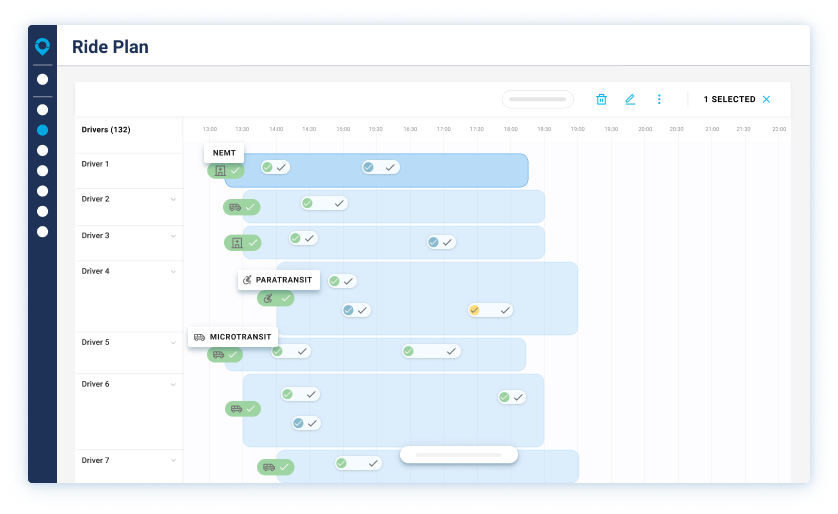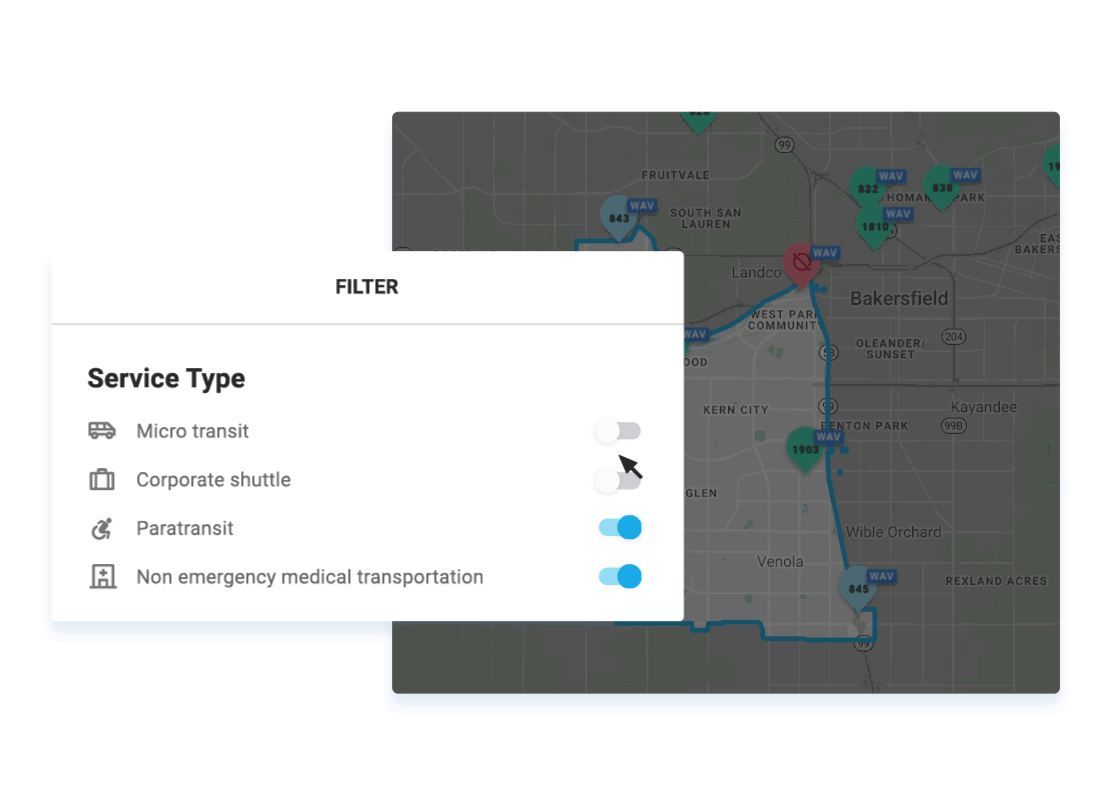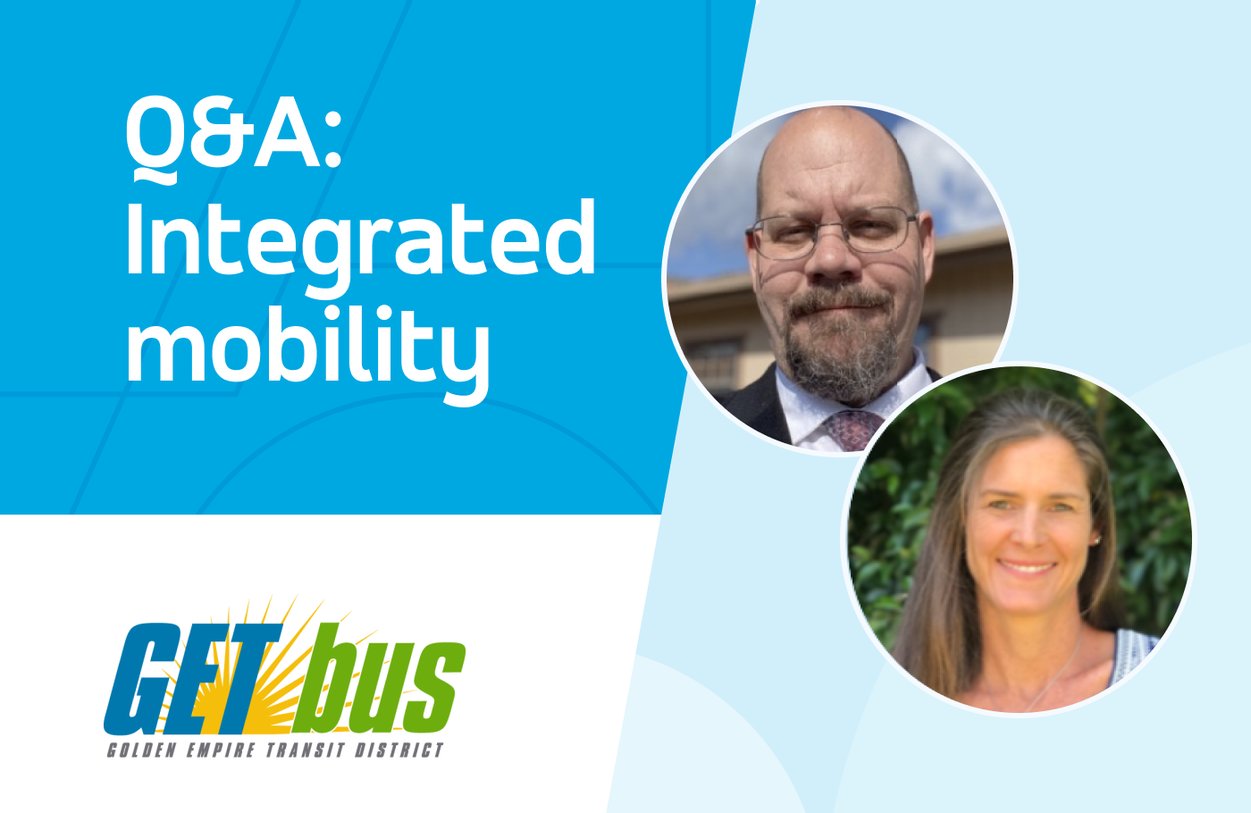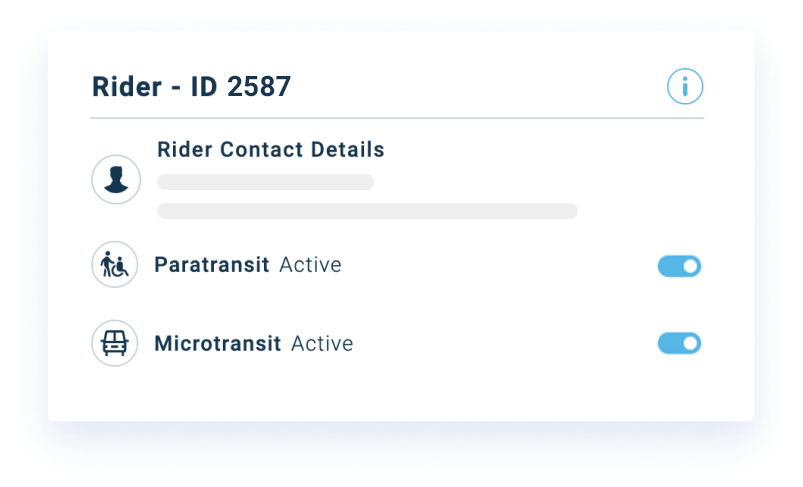
A rendering of how Via's software visualizes commingled fleets, organized by driver shift.
KRISTA GLOTZBACH (KG): I know when I visited your team recently, I saw a really physical representation of what an Integrated Mobility Solution can do. When I first came down to Bakersfield years ago, the paratransit and microtransit dispatchers were in two separate rooms and now they’re working together, in one place, on the same platform. Where did the idea of launching an integrated mobility project at GET come from and how did you start your search for a provider?Rider eligibility for paratransit, microtransit, and any other commingled service is visible in the rider’s profile and can be toggled on and off by system operators.
KG: And that’s where this integrated mobility piece comes in — can you talk a bit more about that future of “one service”? The needs of these rider groups are obviously very different: how will you address that?
RW: We’re currently sharing fleets and drivers across our services, and drivers can switch between carrying microtransit, NEMT, and paratransit riders within the same shift. If you have a driver with two paratransit trips booked an hour apart, you can fill in the rest of their shift with microtransit trips and increase efficiency. Our ultimate goal is to commingle all of those riders on the same vehicles, at the same time.
We still follow all of the separate rules, including ADA-specific requirements, and also making sure our microtransit riders do not get negatively impacted by all of those rules as well. We’re basically creating one on-demand service and marketing it and branding it as such — all customer calls go to one phone number and we help them figure out which of our three services they’re eligible for, and they can decide which service works best for them on a trip-by-trip, destination-by-destination basis.
KG: Why is integrated mobility so important to your network?
RW: It’s really about two things: resilience and efficiency. By combining services, we’re able to run more efficiently because we’re putting more people in vehicles and not having all of these blocks of time where drivers and vehicles are just waiting around for very specific types of riders. With the same amount of drivers, we’re able to put more service out for people. So far we’ve seen efficiency gains up to 60% in terms of passengers per vehicle hour.
We’ve also seen training programs improve — largely because we don’t have to train our staff on multiple kinds of software. Our customer service, paratransit, and general operations divisions can ask questions of one another and IT doesn’t have to train all three of those groups separately. And because we not only share drivers, but also share vans themselves across services, if two go down for maintenance, it doesn’t affect us nearly as much. Inside the organization, we’re able to run with fewer dispatchers at a time, so we’re able to deal with vacations and sick time and all of that kind of stuff. It’s the same thing with drivers and customer service agents too. “Our team started to crunch the numbers and realized we could run a 45% farebox recovery ratio with NEMT — which is four times what we need here.” KG: On that topic of freeing up resources and enjoying cost-savings, let’s turn to NEMT — a service in which more of GET’s operating costs are covered by passenger fares and insurance reimbursements. I’m sure other agencies would be interested in learning how your team got involved with that and how it’s working to defray costs across the entire system.
RW: The conversation got started with our local Medi-Cal (California Medicaid) provider. They were serving one-off NEMT trips with private ridehail companies, taxis, and volunteer drivers, and they thought there might be an opportunity for us to serve the trips instead. They came to us and said, “We’ll pay you X amount per ride or per mile, if you’ll come and operate this with our broker.” That means that riders call into the broker, the broker determines eligibility for the service, collects rider information, handles billing, and then sends us a CSV for each trip. Our team started to crunch the numbers and realized we could recover 45% of operating costs through the farebox with NEMT — which is six times what we need to cover the farebox-funded portion of our operating costs.
Even with COVID-19, we’re still at a fairly good clip at about a 22% farebox recovery. And with Via as our software provider, our agents don’t have to manually book all of the rides that the NEMT broker sends us. Via built us a bulk upload tool that reads the CSV and automatically books the trips in the Ride Plan. Then the on-demand software quickly aggregates and assigns those rides. When we were doing everything by hand, we would never have been able to scale our NEMT service, but now we see some real growth potential there. 
On the service map, dispatchers can easily filter by service type — revealing different zone maps and live rides when they do.
KG: Like you said, NEMT is traditionally provided by private taxi companies. How has rider feedback been on using a public transit service to get to and from their medical appointments?
RW: The feedback from the riders has been very positive. All of our drivers are professionally trained, our vans are always clean, and they all look the same so people know exactly what they’re looking for when we pull into the parking lot. The other big thing is that we don't forget anybody. We make sure that we pick them up when their appointment is finished and bring them home, and that’s one of the things that a lot of people aren't used to. It’s not just a one-way ride. We’re really taking care of the customers as a whole, and I think that that’s a big benefit they see. And the Ride Plan helps us maintain that level of service — we can see all of our daily rides across all driver shifts and the software slots in rides efficiently. We don't miss a trip.
KG: As you began taking steps towards this larger, integrated vision, what did you see as the risks?
RW: You’re always worried about failure when you’re doing something new. This is actually the first major-major project that I’ve managed in transit, and I’ve always been told that there’s always going to be problems, glitches, and delays, but with this implementation we actually hit every single one of our marks. My CEO — who previously told me that it was over-ambitious and there was no way we were going to make that happen — said it’s the best technical implementation she’s ever been a part of.





